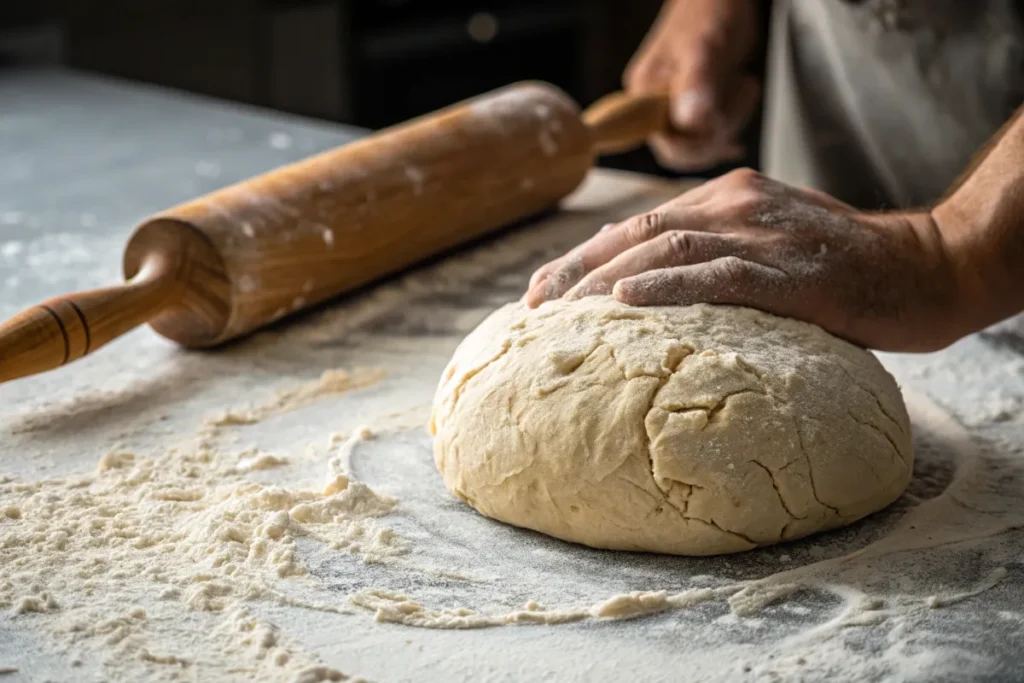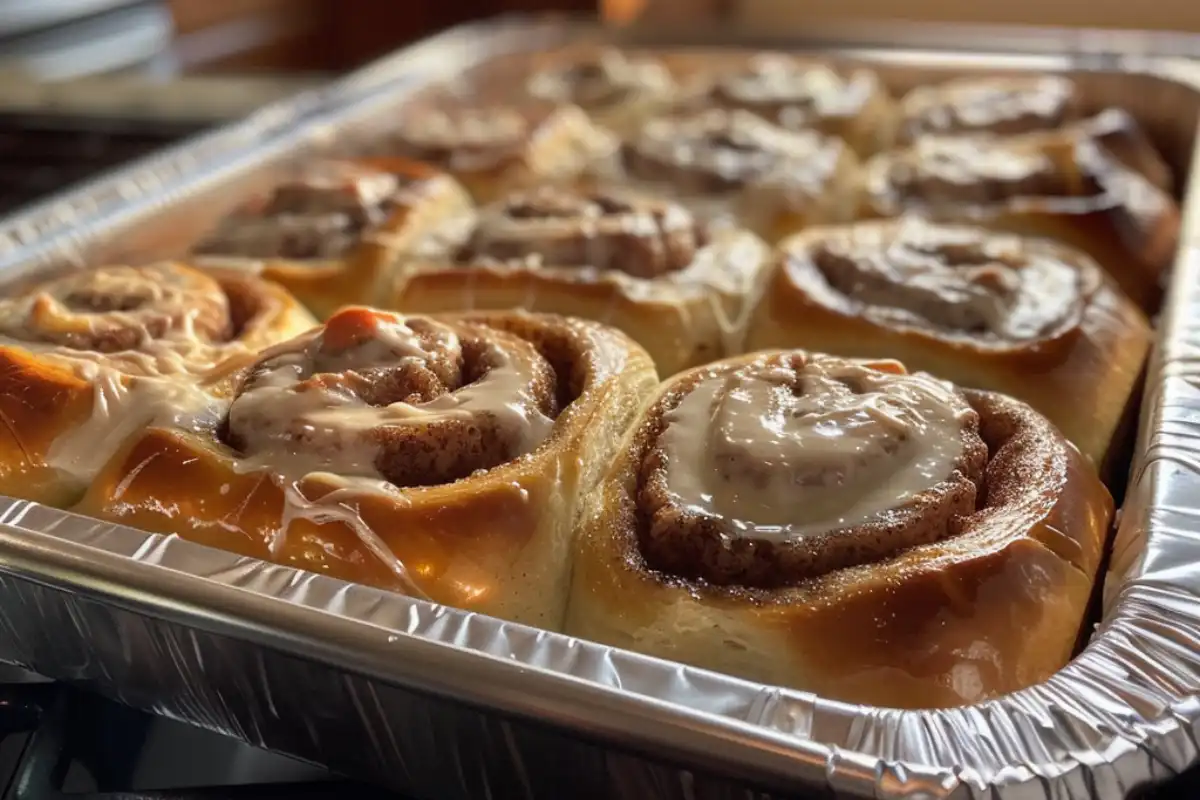There’s nothing quite as disappointing as spending hours baking cinnamon rolls, only to wonder, why are my cinnamon rolls not fluffy? Achieving that perfect, melt-in-your-mouth texture involves more than just following a basic recipe—it requires attention to detail, understanding ingredient interactions, and using proper baking techniques. If your cinnamon rolls consistently turn out heavy and dense, you’re not alone. Many bakers encounter this issue.
Soft, fluffy cinnamon rolls are the hallmark of a great recipe, but getting them right requires precision. Several factors influence their texture, from the type of yeast you use to how long the dough is allowed to rise. If you’ve ever asked yourself, why are my cinnamon rolls not fluffy?, this guide will help you troubleshoot common mistakes and perfect your recipe.
Table of Contents
Common Reasons Why are my cinnamon rolls not fluffy
1. Overworking the Dough

Overworking the dough is one of the most common answers to the question, why are my cinnamon rolls not fluffy? When you knead the dough too much, you develop excess gluten, making the dough tough and less able to expand while baking. Overworked dough results in tight gluten strands, restricting the dough’s ability to rise and leading to a denser, chewier texture.
- How to fix it: Knead your dough just until it’s smooth and elastic. Generally, kneading by hand should take about 5-7 minutes, and using a stand mixer should take 3-4 minutes. Avoid kneading for too long, as this can make the dough stiff.
2. Insufficient Rise Time
If you’ve ever wondered, why are my cinnamon rolls not fluffy?, improper proofing could be the culprit. One of the critical aspects of baking fluffy cinnamon rolls is allowing the dough to properly rise. This process, called proofing, gives the yeast enough time to create air pockets that lead to a soft texture. Under-proofing your dough results in dense, heavy rolls because the yeast hasn’t had enough time to produce the gas needed for the dough to rise.
- Solution: Let the dough rise in a warm, draft-free place for 1-2 hours during the first rise. Allow the shaped rolls to rise again for another 30-45 minutes before baking. Both rises are crucial for creating that signature fluffy texture.
If you're looking for a tried-and-true recipe for soft and fluffy cinnamon rolls, check out these Sourdough Cinnamon Rolls for a delicious and perfectly textured treat!
3. Incorrect Ingredient Ratios
If you’re asking yourself, why are my cinnamon rolls not fluffy?, the issue might be too much flour or not enough liquid in your dough. Cinnamon roll dough requires the perfect balance of flour, butter, and liquid to achieve a soft, light texture. Adding too much flour can make the dough stiff and difficult to roll out, leading to dense rolls that don’t rise properly.
- How to fix it: Use a kitchen scale to measure your ingredients accurately. If you’re using cups, use the spoon-and-level method for measuring flour. Avoid packing the flour into the measuring cup, as this can add more than you intend.
4. Using Cold Ingredients
If you’ve ever asked yourself, why are my cinnamon rolls not fluffy?, cold ingredients could be the culprit. When butter, milk, or eggs are added cold, they can interfere with the yeast’s ability to activate properly, leading to flat, dense cinnamon rolls. Without the right temperature, the yeast becomes less effective, preventing the dough from rising as much as it should.
- Solution: Make sure all your ingredients are at room temperature before adding them to the dough. Allow the butter to soften and the eggs and milk to warm up. You can gently warm the milk to around 100°F to help activate the yeast, but be careful not to overheat it as this can kill the yeast.
5. Expired or Inactive Yeast
Yeast is a crucial ingredient for achieving fluffy cinnamon rolls, and using expired or inactive yeast is a common reason bakers ask, why are my cinnamon rolls not fluffy? If the yeast isn’t active, the dough won’t rise properly, no matter how long you let it proof. Yeast is responsible for creating gas bubbles that make the dough expand and develop a soft, airy texture.
- How to fix it: Always check the expiration date on your yeast package before using it. To test if your yeast is still active, dissolve it in warm water (around 100°F) with a pinch of sugar. After a few minutes, it should foam and bubble. If it doesn’t, your yeast is likely expired or inactive.
For more tips on yeast activation, visit How to Test Yeast for Baking for an in-depth guide.
Step-by-Step Guide to Fixing Dense Cinnamon Rolls
Step 1: Test Your Yeast

If you’ve ever wondered, why are my cinnamon rolls not fluffy?, the first step to ensuring soft, airy rolls is making sure your yeast is active. If the yeast is dead, the dough won’t rise, resulting in dense rolls. To test your yeast, dissolve it in warm water (around 100°F) with a pinch of sugar. If it foams and bubbles after a few minutes, your yeast is active and ready to use.
- Tip: Always use fresh yeast, and store it in a cool, dry place. Once opened, yeast should be kept in an airtight container in the refrigerator or freezer to extend its shelf life.
Step 2: Measure Ingredients Correctly
Using too much flour or not enough liquid will result in dense rolls. To avoid this, measure your ingredients accurately using a kitchen scale for the best results.
- How to fix it: Use the spoon-and-level method for measuring flour if you don’t have a scale. Over-packing the measuring cup will lead to too much flour and a stiff dough. For liquid ingredients, measure using liquid measuring cups to ensure the correct volume.
For a deeper dive into what makes the perfect cinnamon roll filling, check out What Is the Filling for Cinnamon Rolls Made Of? to learn about key ingredients and techniques
Step 3: Knead the Dough Properly
Kneading the dough is crucial for building gluten, which gives the rolls their structure. However, finding the right balance is key—over-kneading can make the dough tough, while under-kneading can leave you wondering, why are my cinnamon rolls not fluffy? If the dough isn’t kneaded enough, it won’t develop the strength needed to rise properly, leading to dense rolls.
- Tip: Knead the dough just until it’s smooth and elastic, which takes about 5-7 minutes by hand or 3-4 minutes with a stand mixer. Avoid over-kneading, as this can make the dough too dense.
Step 4: Give the Dough Time to Rise
After kneading, it’s crucial to let the dough rise in a warm, draft-free place. Skipping this step or cutting it short can leave you asking, why are my cinnamon rolls not fluffy? Without enough time for the yeast to produce gas bubbles, the dough won’t rise properly, resulting in dense rolls instead of the soft, airy texture you’re aiming for.
- How to fix it: Allow the dough to rise until it has doubled in size. This can take anywhere from 1-2 hours, depending on the temperature of your kitchen. After shaping the rolls, let them rise again for another 30-45 minutes before baking.
Step 5: Avoid Overbaking
Overbaking can cause your cinnamon rolls to become dry and dense. The ideal internal temperature for cinnamon rolls is 190°F.
- Tip: Set a timer and start checking your rolls around the 20-minute mark. Use an instant-read thermometer to ensure they’re baked to perfection.
If you’re looking to improve your baking techniques, be sure to also check out The Secret to Moist Cupcakes for more tips on creating soft, airy baked goods.
Achieving fluffy cinnamon rolls requires attention to detail, from the kneading process to the rise time. If you’ve ever wondered, why are my cinnamon rolls not fluffy?, the answer often lies in key baking techniques. By using fresh, active yeast, measuring ingredients accurately, and allowing the dough to proof properly, you can transform dense rolls into soft, pillowy treats
FAQs About Why are my cinnamon rolls not fluffy
1. Why are my cinnamon rolls tough?
- Tough cinnamon rolls are usually the result of over-kneading or using too much flour. Be sure to knead the dough just until it’s smooth and elastic, and measure your ingredients carefully.
2. Why are my cinnamon rolls dry after baking?
- Dry cinnamon rolls can be caused by over-baking or not using enough liquid in the dough. Consider adding more moisture to the filling or reducing the baking time.
3. How long should I let cinnamon rolls rise?
- Cinnamon rolls should rise for 1-2 hours during the first proof and 30-45 minutes after shaping. Ensure the dough has doubled in size before baking.
4. Can I make cinnamon rolls fluffier by using bread flour?
- Yes, using bread flour can result in fluffier rolls because it contains more protein, which helps the dough rise higher and become airier.
5. Why did my cinnamon rolls collapse in the middle?
- Cinnamon rolls may collapse if they are under-baked or under-proofed. Make sure the internal temperature reaches 190°F and that the dough has risen fully before baking.

